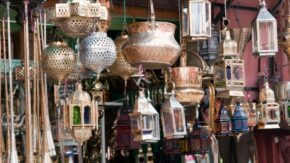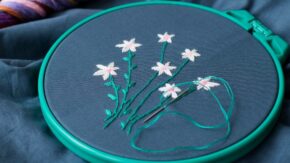Homeware or houseware crafting is when we create functional or decorative items for use in their home or garden. Examples of this are embroidery, woodworking, candle making, and glass crafts are different homeware crafting forms.
That’s a very broad topic, and this guide provides an overview of the different types of houseware crafts, the materials and tools you’ll need, and how to get into your chosen homeware craft.
The tools you’ll need to make housewares vary tremendously depending on what niche you choose to specialize in. The materials you need vary massively between crafts, ranging from embroidery thread and needles to lumber and screwdrivers.
Whatever homeware craft you decide to learn, there are many benefits to be had. Crafting can be quite relaxing and destressing, you’ll enjoy a huge sense of achievement when you complete a project, and you could save money by making unique and useful items for your home.
You can create a huge range of products for your home, including soft furnishings, wooden furniture, concrete garden ornaments, greeting cards, and scented candles.
If you’re not sure what homeware craft you want to try, read this guide for inspiration!
What Is Homeware Craft?
Homeware craft is the term used to describe the act of making something functional or decorative for use around your home or garden. The homeware definition includes things like soft furnishings, garden ornaments, furniture, decorative wall hangings, pottery tableware, and glass decorations.
What Are The Different Types Of Homeware Crafts?
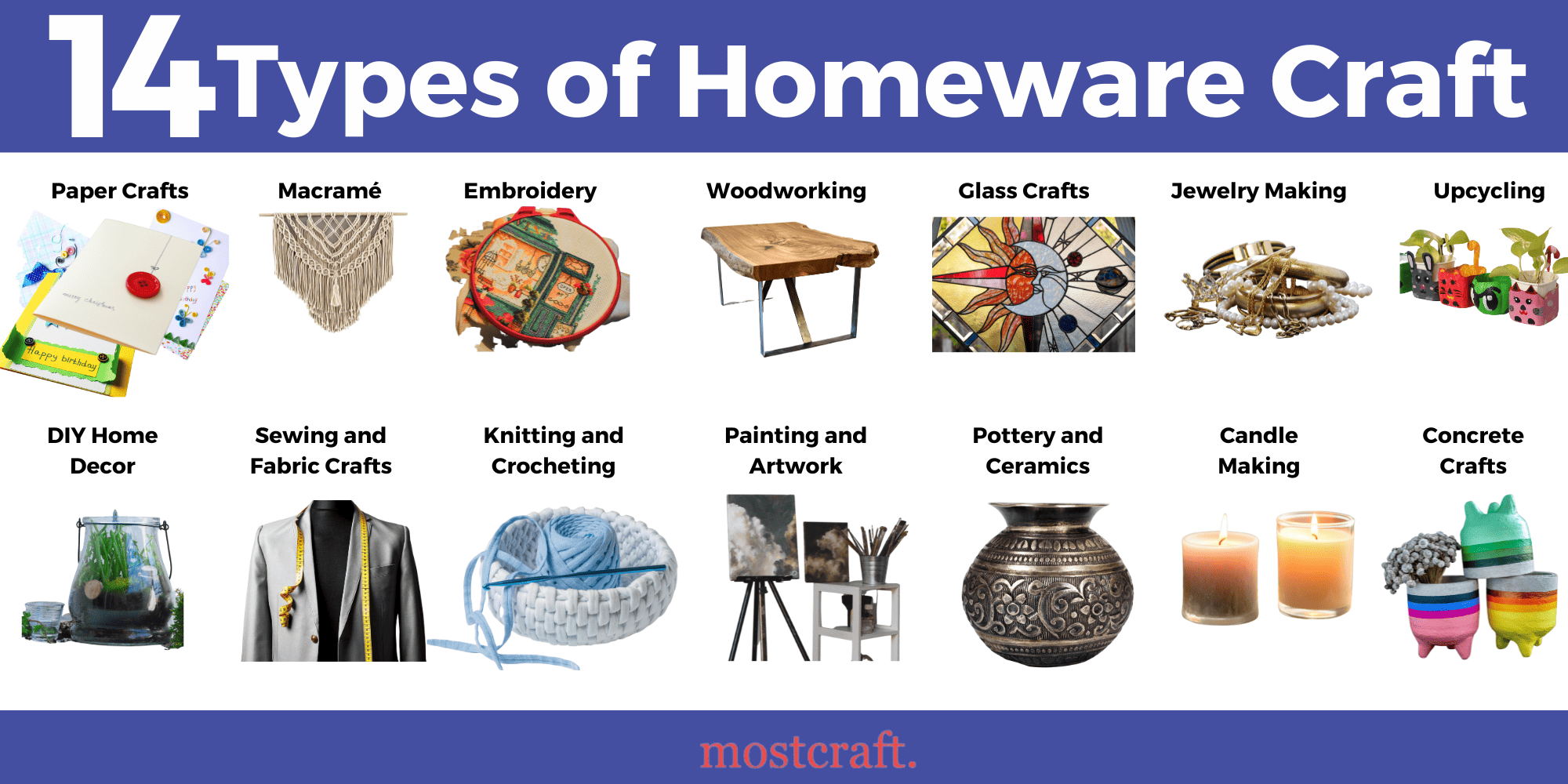
The different types of homeware crafts encompass a wide range of creative endeavors that can transform everyday items into functional and decorative pieces for your home. There’s a huge range of homeware crafts to choose from, so you really are spoiled for choice! Some of these crafts require a delicate touch, whereas others require more brute force!
In this part of our guide, we provide an overview of the most popular homeware crafts you can choose to get into.
Sewing And Fabric Crafts
Sewing and fabric crafts include things like making cushion covers, quilts, throws, and drapes. Essentially, anything that requires a needle and thread to make it fits into this category.
Knitting And Crocheting
Knitting and crocheting are absorbing crafts that involve using knitting or crochet needles to create clothing items and decorative pieces from yarn.
Candle Making
If you take up candle making, you’ll probably need a dedicated workshop and plenty of storage space. With this craft, you can create bespoke scented candles to brighten up your home’s interior or to give as gifts.
Pottery And Ceramics
Pottery and ceramics are very hands-on crafts, using different media, such as clay, to make decorative items and tableware. If you take up this craft, you’ll need a workshop with a kiln and plenty of storage space for your materials.
Woodworking
Woodworking, as you can guess, involves using wood to build furniture and functional items for use around your home and garden.
Glass Crafts

Glass crafts include making decorative objects and windows, often using stained glass, with artisans carefully selecting and arranging colored glass pieces to create stunning patterns and designs.
Jewelry Making
If you don’t have a lot of space, jewelry making is a good craft to try. You can do much of your crafting at your kitchen table, provided you can store your tools and supplies somewhere.
Paper Crafts
Paper crafts can be done in the comfort of your living room, including making greeting cards and elaborate paper or card decorations. This form of crafting is very popular with kids, too.
Macramé
Macramé is a form of textile that’s made by knotting cords to create a decorative wall hanging or other item for your home.
Painting And Artwork
If you have an arty streak, you might want to take up painting to create various artworks to decorate your home, adding a personal touch to your living space that reflects your unique style and creativity.
DIY Home Decor
DIY home decor refers to any piece of decorative or functional craft, from tableware and drink coasters to wall art and garden ornaments.
Upcycling
Many crafters who are environmentally aware choose upcycling as their craft of choice. Upcycling basically means using old, unwanted items and turning them into something new and useful. You could upcycle old things you have lying around your home or take a trip to your local thrift or charity shop and see what inspires you there.
Concrete Crafts
As the name suggests, concrete crafts include anything made using concrete, such as planters and molded garden ornaments.
Embroidery
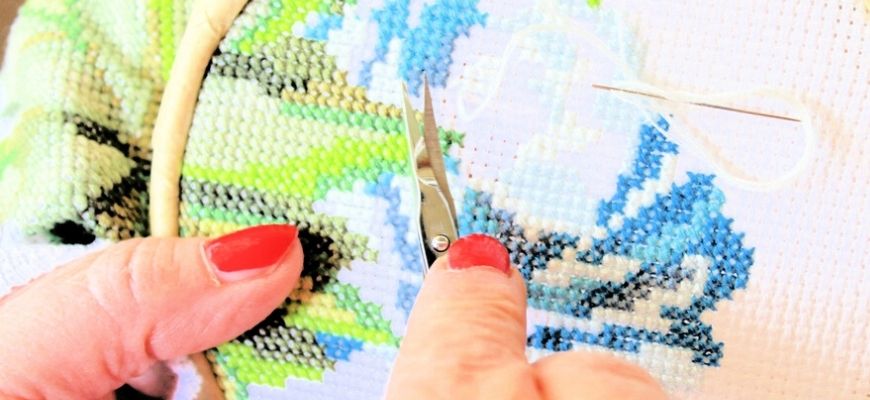
Embroidery is a very popular homeware craft that uses thread to stitch patterns and designs onto pieces of fabric. You can use embroidery to make decorative pieces for your home or to embellish and enhance items of clothing.
What Are The Most Common Tools For Homeware Craft?
The most common tools for homeware craft vary depending on what niche you want to try. However, whatever homeware craft you choose to get into, you will need a range of specific tools.
In this part of our guide, we give you an idea of the most common tools you would need for each of the most popular homeware crafts.
Sewing And Fabric Crafts
The sewing and fabric crafts category encompasses various projects that involve using a needle and thread, such as creating cushion covers, quilts, throws, and drapes.
Sewing Machine
Although you can sew most things by hand, you’ll find a sewing machine makes the process quicker and much easier. You don’t need to spend a fortune on a machine when you start out. There are lots of inexpensive basic models that are fine for basic work, and you might find a secondhand one on one of the online auction sites.
Scissors
A sharp pair of scissors with ergonomic handles is essential for sewing and stitch crafting. If your scissors are blunt, they will tear and fray the fabric you’re working with and leave yarn and cotton with blunt ends, making it difficult to thread a needle. So, you cannot skimp on a decent pair of scissors!
Fabric Pins
A box of sharp fabric pins is another essential for sewing and fabric crafts. Pins are used to hold your fabric pieces together until you’ve stitched them.
Measuring Tape
Lots of fabric crafts, including dressmaking, need accurate measurements, so you’ll need a measuring tape. For fabric crafting, a material tape is preferable to a stiff, metal one.
Knitting And Crocheting
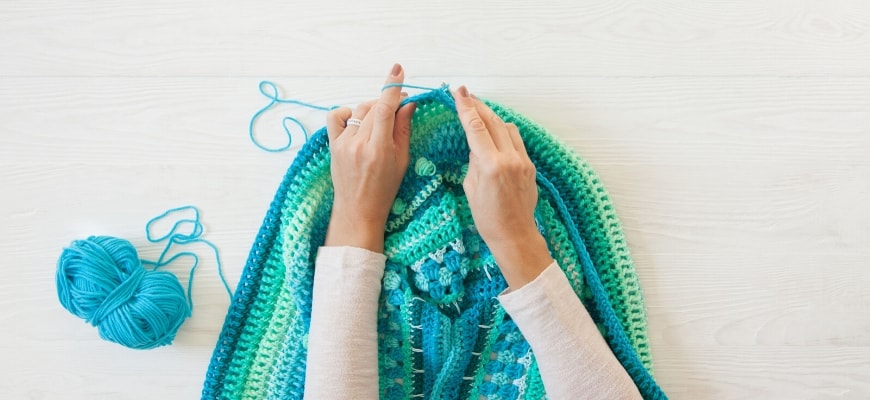
Knitting and crocheting are crafts that are used to make clothing and decorative items from yarn.
Knitting Needles
If you decide to take up knitting, you’ll need a variety of knitting needles of different sizes. Each knitting pattern tells you what size needles you need; over time, you will quickly accumulate a range of needles.
Crochet Hooks
Crochet hooks come in different sizes, materials, and shapes. However, all you really need is a short, smooth, thin crochet hook that is strong enough for you to turn yarn into the stitches that create the crocheted fabric.
Yarn
Yarn can be made from natural or synthetic fibers such as wool or polyester. Yarns come in many different weights, colors, and finishes, and it’s up to you to choose how you want your finished project to look.
Stitch Markers
Stitch markers are useful in helping you keep your place, remember to swap out colored yarns and nail complicated stitches. Although you probably won’t need one for basic work, as your projects become more advanced, you might find a stitch marker helpful.
Candle Making
If you like to have real candles lighting up your home, you might fancy trying candle-making as a houseware craft. In recent years, scented candles have mushroomed in popularity, and you could save a fortune by making your own. Of course, candles also make great gifts for family and friends.
Double Boiler
In candle-making, a double boiler is used to heat and melt your wax. The method is pretty simple and involves placing a pouring jug containing the wax into a pot of hot water and heating the wax slowly and evenly until it melts.
Candle Wicks
You’ll need candle wicks in your candles if you want to burn them, so a supply of these is essential.
Thermometer
In candle-making, a thermometer is an essential tool that enables you to monitor the control the wax’s temperature.
Pottery And Ceramics
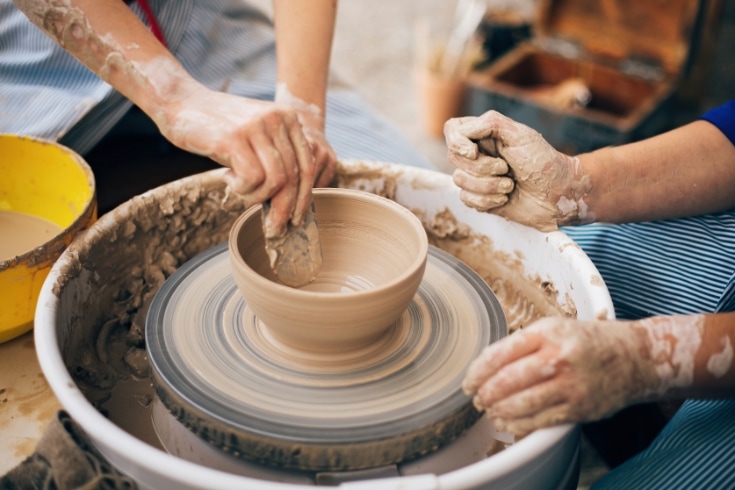
Pottery and ceramics demand quite a lot of workspace because of the tools you’ll need to use in this craft, including pottery wheels, kilns, and various sculpting instruments.
Pottery Wheel
Once you’ve prepared your clay, you need to work it on a pottery wheel to create the shape you want, especially if you’re making items like bowls, jugs, and the like.
Clay
Clay is a crucial raw material in pottery and ceramic crafting. Once you’ve finished your finished clay piece, you can seal the clay to make it less porous and paint or glaze it to decorate the item.
Kiln
Clay must be fired at a hot temperature in a kiln to harden it. Kilns are typically large items that you’ll need to keep in a dedicated workshop, ideally outside your home, for safety.
A kiln isn’t a cheap purchase, so getting hold of a secondhand, cheaper one might be a good start to your crafting hobby.
Pottery Tools (E.G., Carving Tools, Modeling Tools)
You’ll need a range of pottery tools for carving and modeling the pieces you make. Start with a few basic items and gradually build up your collection as you become more proficient and take on more challenging projects.
Woodworking
Woodworking needs a range of different tools, plenty of storage, and a suitable working space. Essentially, this craft involves making things out of wood for your home and garden.
Saw (E.G., Circular Saw, Jigsaw)
A selection of different saws is essential for woodworking, depending on the size and complexity of your projects.
Hammer
Hammers are useful for knocking in nails and joints and come in a range of sizes and weights, according to your needs.
Screwdriver Set
Screwdrivers are used to fix screws into pieces of wood to fasten the elements of a project together. It’s a good idea to buy a set of screwdrivers of different sizes, and a battery-operated one can save you some elbow grease!
Sandpaper
For a smooth finish, you’ll need sandpaper to remove rough edges and surfaces from the wood you’re working with.
Sandpaper comes in different gauges, from fine to coarse.
Glass Crafts
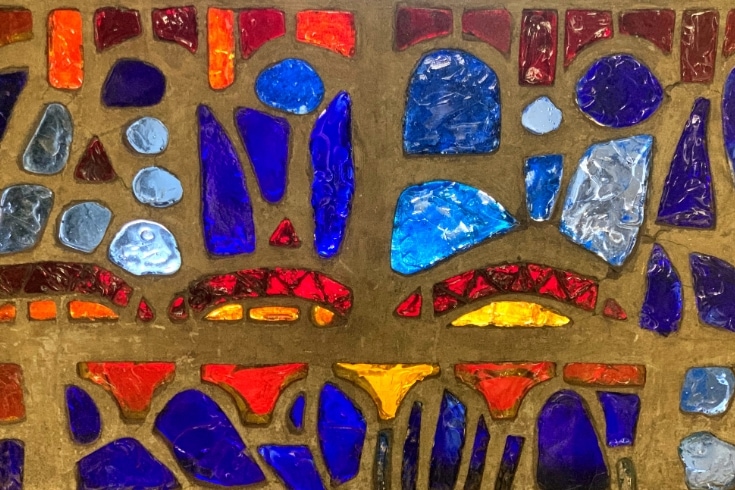
Like pottery and woodworking, glass crafts demand a dedicated working area and some specialist equipment. Again, it’s a good idea to buy secondhand tools if possible to save money. That way, if you decide that glass crafts are not for you, at least you didn’t break the bank.
Glass Cutter
Glass generally comes in sheets; a glass cutter, a specialized tool with a sharp, diamond or carbide wheel, is indispensable for precisely cutting out the shapes you want in glass crafting projects.
Glass Grinder
Glass grinders are used to reshape glass pieces so that they fit into stained glass windows and other decorative pieces.
Soldering Iron (For Stained Glass)
If you’re making a stained glass piece, you’ll need a soldering iron to fuse the framework together that contains your glass.
Safety Glasses
Working with glass can be dangerous, especially if fragments of ground or cut glass fly up into your eyes, so you’ll need a set of safety glasses.
Jewelry Making
Jewelry making is an extremely popular hobby that you can carry out from the comfort of your living room or kitchen table, depending on what kind of jewelry you want to make and the processes you need to use.
Pliers (e.g., Round-Nose, Chain-Nose)
You need two pairs of pliers to manipulate small items and create 90-degree bends in jewelry wire, and twist jump rings apart and close them again for basic assembly of your pieces.
Wire Cutters
Wire cutters are required to cut wire. Choose cutters that have a flat or flush side for a neater finish and save yourself time.
Jewelry Beads
Jewelry beads are tiny decorative objects that come in various shapes and sizes and in different materials, such as shell, stone, glass, wood, pearl, or plastic. Beads have a small hole for stringing or threading.
Jewelry Wire
Jewelry wire is used to hold jewelry beads and the like and comes in brass, copper, silver, aluminum, nickel, and gold.
Paper Crafts
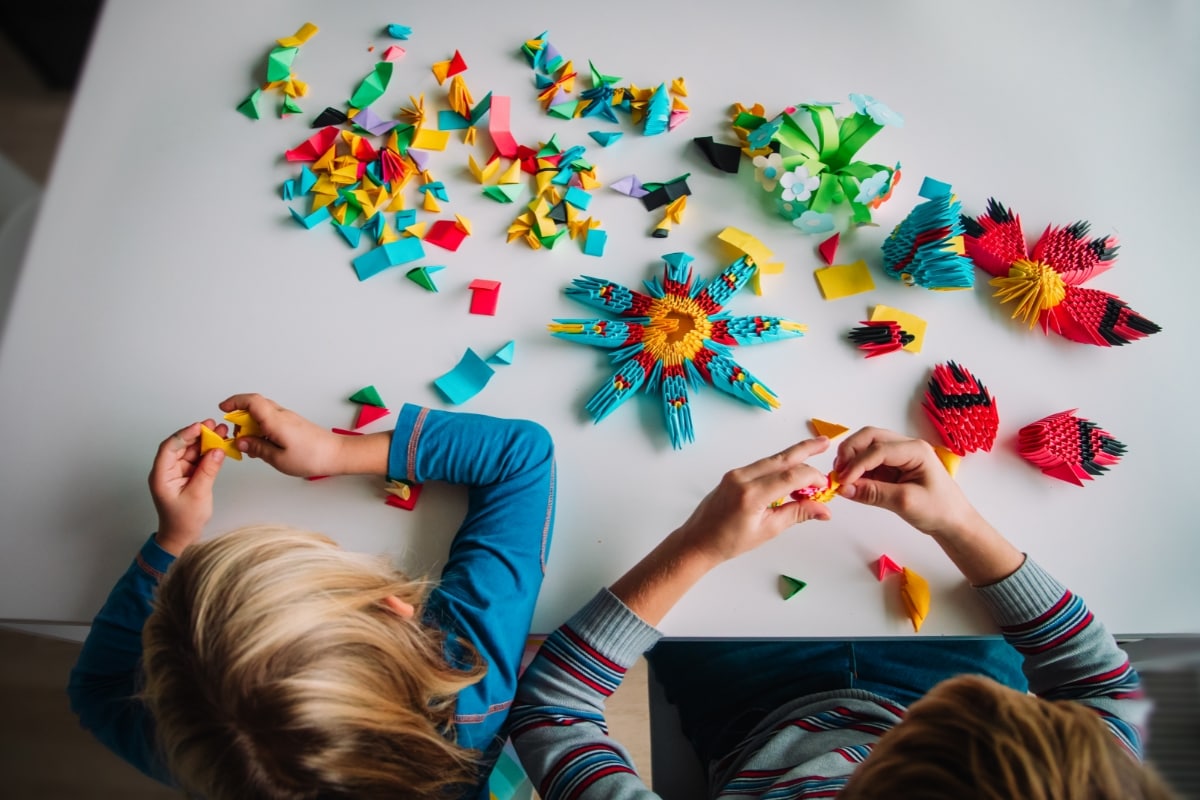
Paper crafts are a form of houseware crafting that is growing in popularity. You can make anything from greeting cards to colorful, floral arrangements using paper and card.
Scissors
A sharp pair of paper scissors is essential if you want to get into this form of houseware crafting. You might also want to buy some pinking shears to create a more interesting edging to your cards.
Craft Knife
A craft knife is used to cut paper, card stock, foam, and fabric. Rather than using scissors, you can keep your material flat on a surface, giving higher precision and accuracy.
Cutting Mat
If you’re planning on using a craft knife to cut your paper and card, you’ll need a cutting mat to place the paper on, as it not only protects your work surface but also ensures smoother and more precise cuts while extending the life of your craft knife blade.
Glue And Adhesives
To fix decorations and embellishments to your paper creations, you will need a selection of different adhesives and glue.
Macramé
Macramé uses knotted cords to create decorative wall hangings for your home. This craft can easily be done at your kitchen table and doesn’t need a whole bunch of tools.
Macramé Cord
Macramé cord comes in a vast array of colors and weights. To begin with, I suggest you start with a 3-ply cotton rope, as that’s ideal for beginners. This versatile cord can be used to make wall hangings, clothing, and home decorations.
Macramé Rings Or Hoops
Macramé rings, or frames, make crafting plant holders from macramé cord much easier and less fiddly, which is perfect if you’re a beginner.
Macramé Board (For Knotting)
Macramé board is used to hold the macramé cord in place while you wrap, tie knots, and plait. Basically, you insert pins into the board to hold the cord in place.
Painting And Artwork
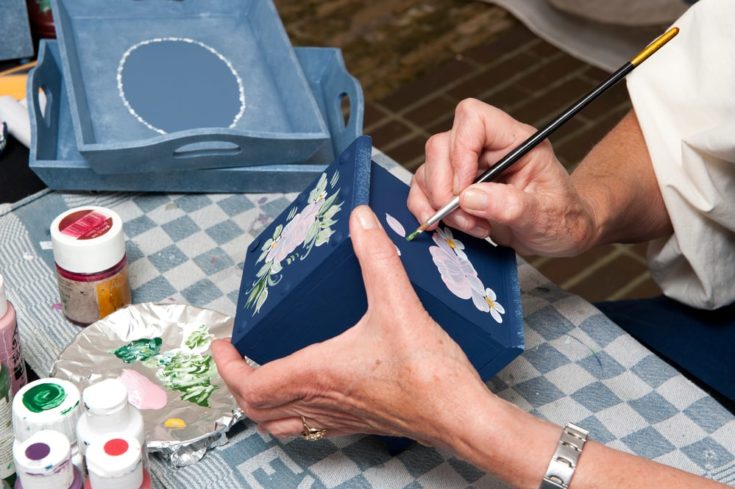
As you can imagine, you’ll need quite a lot of basic tools for painting and artwork if you decide to take up this form of houseware crafting.
Paintbrushes
First of all, you’ll need a selection of paintbrushes of different sizes. Always buy the best quality brushes you can afford because they’ll last longer and produce better results than cheap ones.
Acrylic Or Watercolor Paints
The kind of paint you buy depends on the medium you want to use. The most popular paints are acrylic or watercolor, and both of these are relatively inexpensive and come in a dazzling array of colors.
Canvas Or Paper
Choose from paper or canvas to paint on and ensure you have somewhere dry, cool, and out of direct sunlight in which to store your stock and completed projects.
Easels
It’s much easier to paint a subject if you have an easel to hold your paper while you’re working. You don’t have to spend a fortune on an easel to begin with. A basic model will be fine until you decide whether this form of crafting is right for you.
DIY Home Decor
DIY home decor covers pretty much any form of crafting you can name, although people usually associate the term “DIY” with larger projects like painting and decorating. With that in mind, here are a few of the essentials you’ll need for DIY home decor crafts.
Hot Glue Gun
A hot glue gun is a useful tool that’s handy for applying adhesive quickly and smoothly to secure two objects together, making it a popular choice for various DIY and crafting projects.
Paints And Brushes
A selection of brushes of different sizes is useful for DIY painting jobs around your home, and you can choose whatever paints you need as you go along.
Sandpaper
Sandpaper is useful for smoothing rough surfaces in preparation for painting or sticking objects to. Sandpaper comes in different gauges, from fine to coarse, so stocking up on a selection is helpful.
Drill And Screws
A basic drill with a variety of different bits and a box of screws of different sizes for use in wood, plaster, and tile is a handy addition to your toolkit.
Upcycling
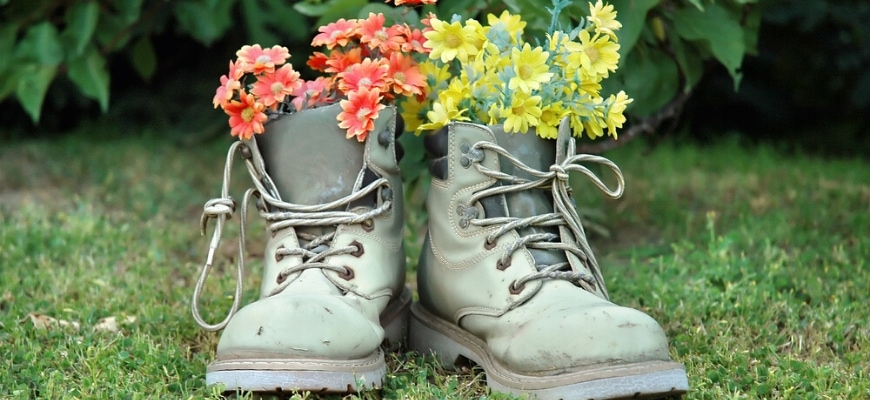
Upcycling uses unwanted or broken items to create new useful things. There are dozens of crafting websites devoted to upcycling, so take a look around online for inspiration.
Screwdriver Set
A screwdriver set containing different-sized flat and Phillips screwdrivers is a handy addition to your toolbox.
Glue And Adhesives
A selection of different types of glue and adhesives is handy for upcycling crafting, enabling you to effectively repurpose and transform materials into unique and sustainable creations.
Concrete Crafts
Concrete crafts are usually used to make garden ornaments and planters. Since this form of crafting can be quite messy, a workshop or large garage is handy to have at your disposal.
Concrete Mix
Depending on what project you’re working on, a multipurpose concrete mix is usually a pretty good choice to have in stock.
Molds Or Forms
Working with concrete to make ornaments for your garden generally requires using preformed molds or forms that you can get from specialist suppliers.
Trowel Or Spatula
You’ll need a few trowels or spatulas to help level and smooth wet concrete, and it’s a good idea to gather a few different sizes to suit whatever project you’re working on.
Protective Gear (Gloves, Mask)
Concrete dust can be unpleasant to work with, getting into your eyes and throat, so protective gear, including gloves and a mask, is essential.
Embroidery
Embroidery is a great way of decorating plain fabrics, upcycling old clothing, and giving life to old clothes from charity shops.
Embroidery Hoop
An embroidery hoop helps to keep your fabric still while you’re stitching, ensuring greater precision and control in your embroidery projects.
Embroidery Needles
Embroidery needles come in different sizes, although they all work in basically the same way. Top tip – Choose a needle that suits you and stick with that!
Embroidery Floss
Embroidery floss or stranded cotton is a six-strand, loosely twisted, glossy thread, usually made of cotton but also manufactured in linen, rayon, and silk. You can choose from a plethora of colors and finishes, depending on the look you want.
Fabric
You’ll need plain fabric as a backing for your embroidery designs, with linen and cotton being popular choices.
What Are The Most Common Materials Used For Homeware Craft?
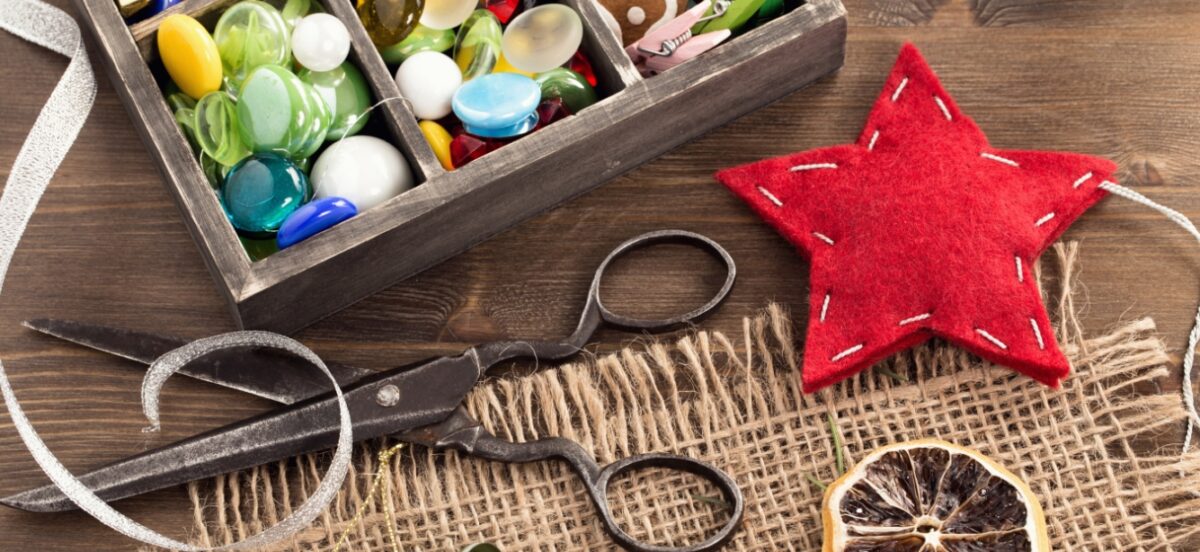
The materials you need for homeware craft vary widely, depending on the nature of the craft you choose to take up, so it’s essential to select materials that align with your project’s design and functionality.
Sewing And Fabric Crafts
The most common materials used for sewing and fabric crafts are listed below, and they offer endless possibilities for creating custom textiles and home decor items.
Buttons
Buttons are used as fastenings for clothing and can also make decorations for cushions and the like. Buttons can be made from wood, plastic, pearl, and glass and come in a wide range of shapes and colors.
Zippers
A zipper is used to fasten items of clothing and cushion covers, and you can also use them as decorations.
Elastic
Elastic is used in dressmaking to gather waistbands, cuffs, etc., providing both comfort and flexibility for a perfect fit.
Ribbon
Ribbons can be made from silk and satin and come in a huge range of colors, widths, and textures. Ribbon is generally used to enhance and decorate clothing, soft furnishings, and wall hangings.
Fabric Paint
Fabric paint can be used to decorate materials used for decoration and comes in a vast range of colors and hues.
Velcro
Velcro is used as an alternative fastening material if you don’t want to use a zipper. That’s especially handy if you make kids’ clothes when buttons are too fiddly.
Knitting And Crocheting
When it comes to knitting and crocheting, the range of materials you can use is somewhat overwhelming! Here are some of this houseware craft’s most commonly used things.
Yarn
Yarn is essential for both knitting and crochet and can be cotton, wool, or synthetic. Choose from different colors and thicknesses, depending on your project and the result you want to achieve.
Stitch Markers
Stitch markers, as described earlier in this article, are used to help keep your place in a pattern or tell you when to change the color of the yarn you’re using.
Knitting Patterns
Knitting patterns tell you what stitches to use, what size needles you need, and what kind of yarn works best for your chosen item.
Candle Making
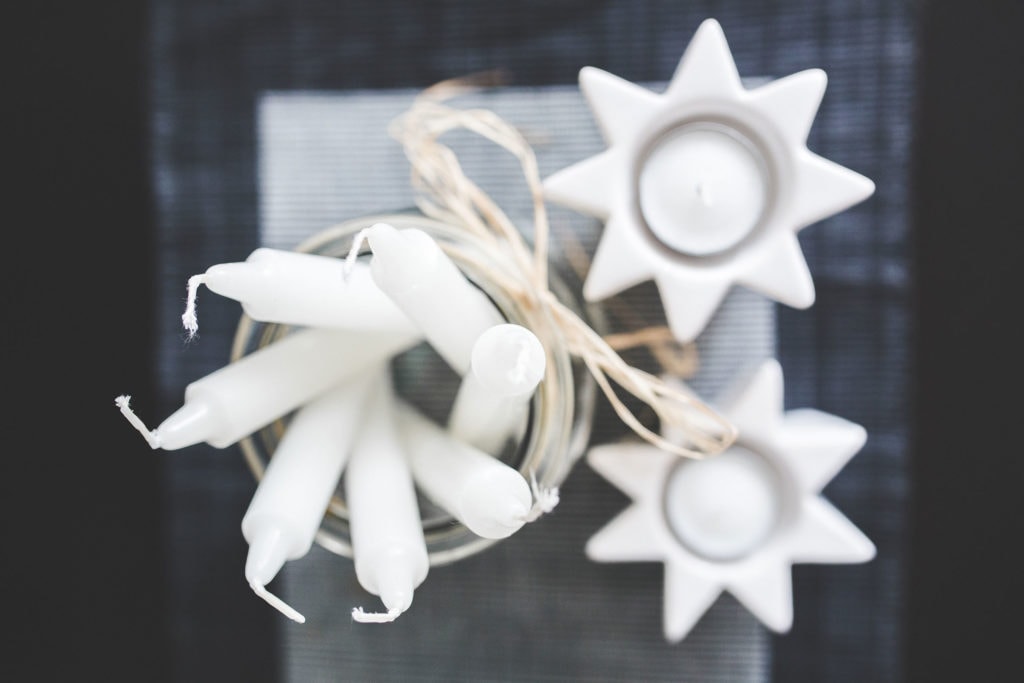
Homemade candles make wonderful gifts for family and friends and provide plenty of scope to challenge your creativity because they can both look and smell gorgeous!
Fragrance Oils
Fragrance oils can be used to give your candles a delightful scent as they burn. Try mixing oils to create your own unique, signature scent.
Candle Dye
Candle dye can give your creations and lovely subtle shade or make a bold statement; it’s entirely up to you!
Candle Molds
There’s more to candle making than just simple tealights! Candle molds are available in many different shapes and sizes to suit your project.
Pottery And Ceramics
Once you’ve made your pottery or ceramic project and fired it, you’ll need to decorate your creation.
Glazes
Glazes can help color your piece, give it a glossy finish, and make it water-resistant. Glazes not only add color and gloss but also make your piece water-resistant, enhancing its longevity.
Ceramic Underglazes
Underglaze is applied to the ceramic piece before the finishing glaze layer. Ceramic underglazes are often used by artists to add vibrant colors and intricate details to their pottery creations before they are fired in the kiln.
Woodworking
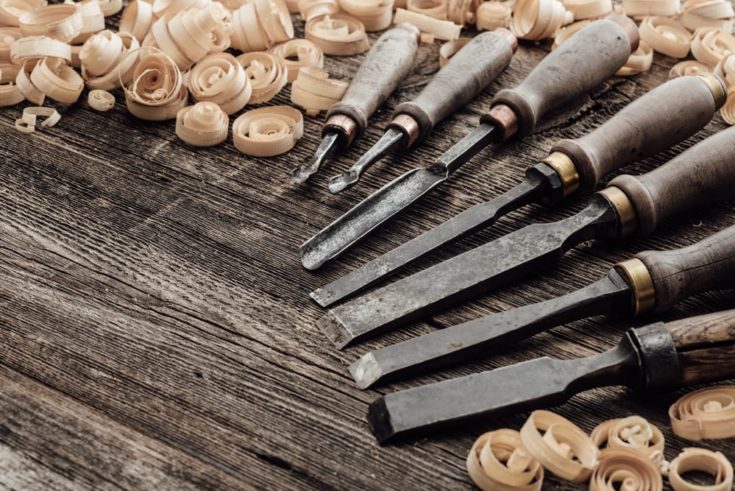
If you take up woodworking, you could make furniture for your home or fix and upcycle items from local thrift and charity shops. Either way, you’ll need a few basic materials to get you started.
Lumber
Depending on your chosen project, you’ll need softwood or hardwood lumber and somewhere dry and cool to store it.
Wood Stain
Unless you plan on leaving your projects looking completely natural, you’ll need a selection of different wood stains to color your woodwork.
Wood Glue
Most woodworking projects need a bit of wood glue to secure surfaces together, ensuring a strong and durable bond that can withstand the test of time.
Glass Crafts
If you decide to take up glass crafts, you’ll need these essential materials and somewhere safe to store them.
Stained Glass Sheets
Stained glass sheets come in different styles, depending on whether you want to create something that gives you privacy or is more transparent. A dazzling range of beautiful colors is available, so let your creative side run riot!
Glass Frit And Chips
Glass frit and chips are raw materials that can be used or combined with other materials to create a custom blend. Frits are used in glass crafts, decorative enamels, and pottery glazes.
Copper Foil Tape
Copper tape is used in stained glass artwork to wrap the glass pieces and create a useful guideline to follow when soldering individual glass pieces together to make the final image.
Jewelry Making
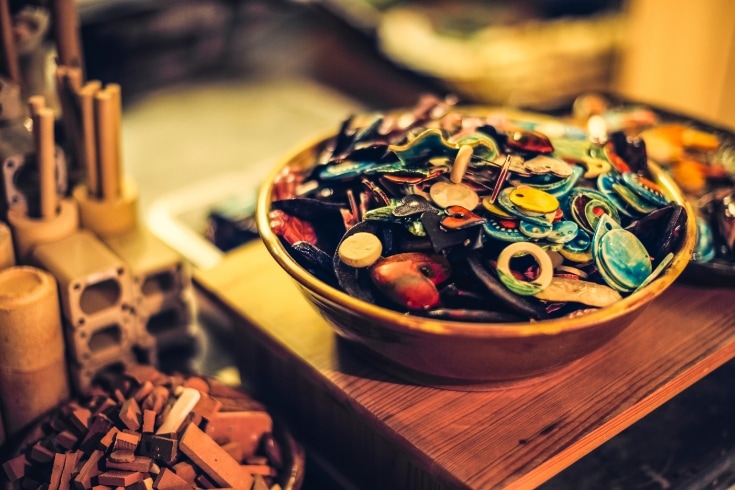
Most crafters gravitate toward a particular form of jewelry, such as enamel or semi-precious stones. However, whatever your preference, you’ll need a range of the following materials.
Jewelry Beads
Jewelry beads can be plastic, pearlized, wooden, or glass. The beads come in lots of different sizes and shapes, all with holes through the center for threading onto jewelry wire.
Jewelry Wire
Jewelry wire is used to hold jewelry beads and comes in copper, aluminum, gold, silver, and other metals.
Clasps And Findings
Clasps and findings are the items used to piece your jewelry together, including clasps, jump rings, head and eye pins, and connectors. They come in various metal finishes, such as copper, gunmetal, silver tone, brass, and gold.
Gemstones And Crystals
Jewelry crafters love to use crystals and gemstones, and there are lots to choose from in different colors, shapes, and sizes.
Jewelry Chain
Jewelry chain is used to make pendants, bracelets, etc. The chain comes in different metals, weights, and link styles.
Macramé
Macramé is a popular hobby that’s used to make decorative housewares like plant holders and wall hangings.
Macramé Cord
Macramé cord is the yarn you need to create your craft piece. Choose from different colors and thicknesses of cord.
Wooden Beads
Wooden beads are used to enhance some macramé pieces and come in different sizes and colors.
DIY Home Decor
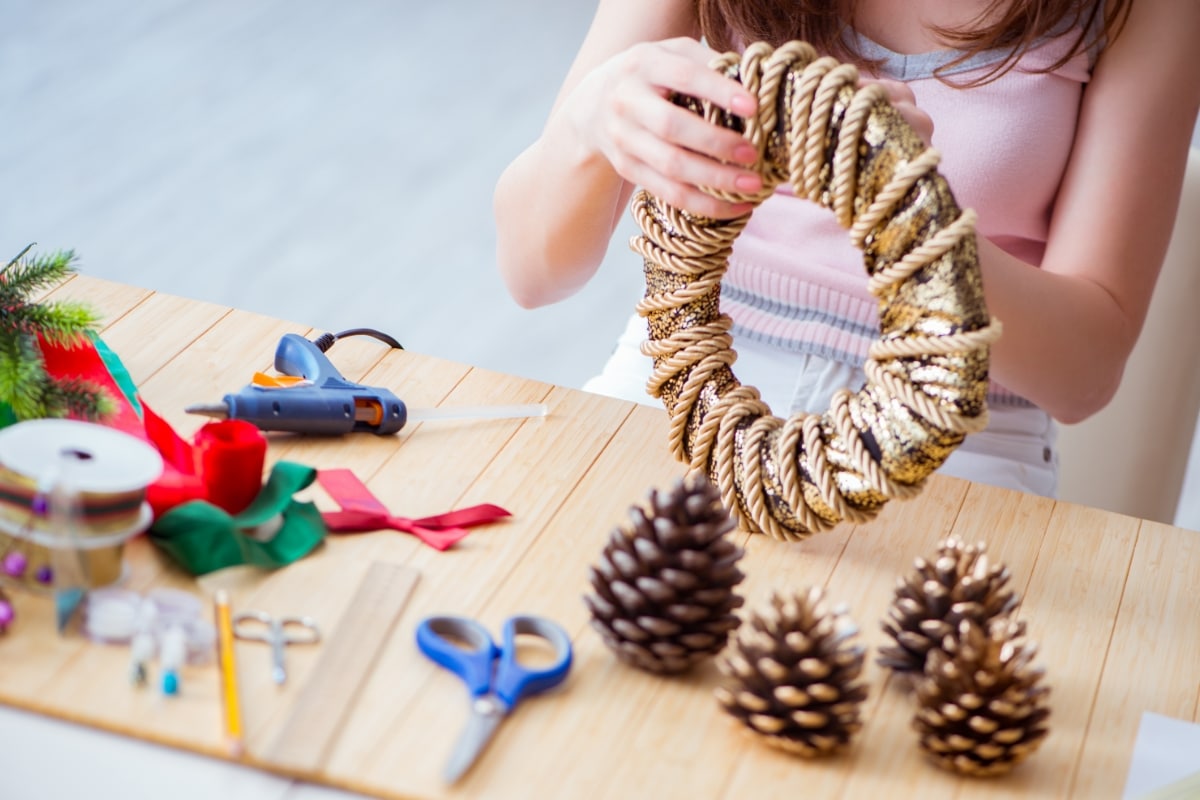
DIY home decor is an umbrella term that describes a whole range of crafting projects, and you’ll need many of the following materials.
Hot Glue Sticks
Hot glue sticks are used with a hot glue gun to stick stuff together, making them a versatile and convenient adhesive choice for a wide range of DIY and craft projects.
Wood Boards
Wood boards are widely used in many DIY and woodworking projects and come in many different types of wood to suit your needs
Metal Hardware
Metal hardware includes items like door hinges, door handles, bolts, nails, screws and other metal fittings.
Decorative Fabrics
If you’re into making home furnishings like cushions and drapes, you’ll need a range of decorative fabrics.
Wall Decals And Stencils
Wall decals and stencils can be used to create a unique finish to a room decor scheme and come in many different designs, shapes, and colors.
Upcycling
Upcycling is a great hobby for you if you want to save money and the planet, as it allows you to creatively repurpose items that might otherwise end up in landfills.
Recycled Materials
You can use any recycled materials, including glass jars, bottles, and old clothes, to unleash your creativity and transform these items into new and unique creations.
Paints And Finishes
A range of different paints and wood stains are handy for updating recycled pieces to give them a new look.
Salvaged Hardware
Hardware can be expensive to buy, and salvaged items are a great alternative, especially if you want to create a vintage look.
Concrete Crafts
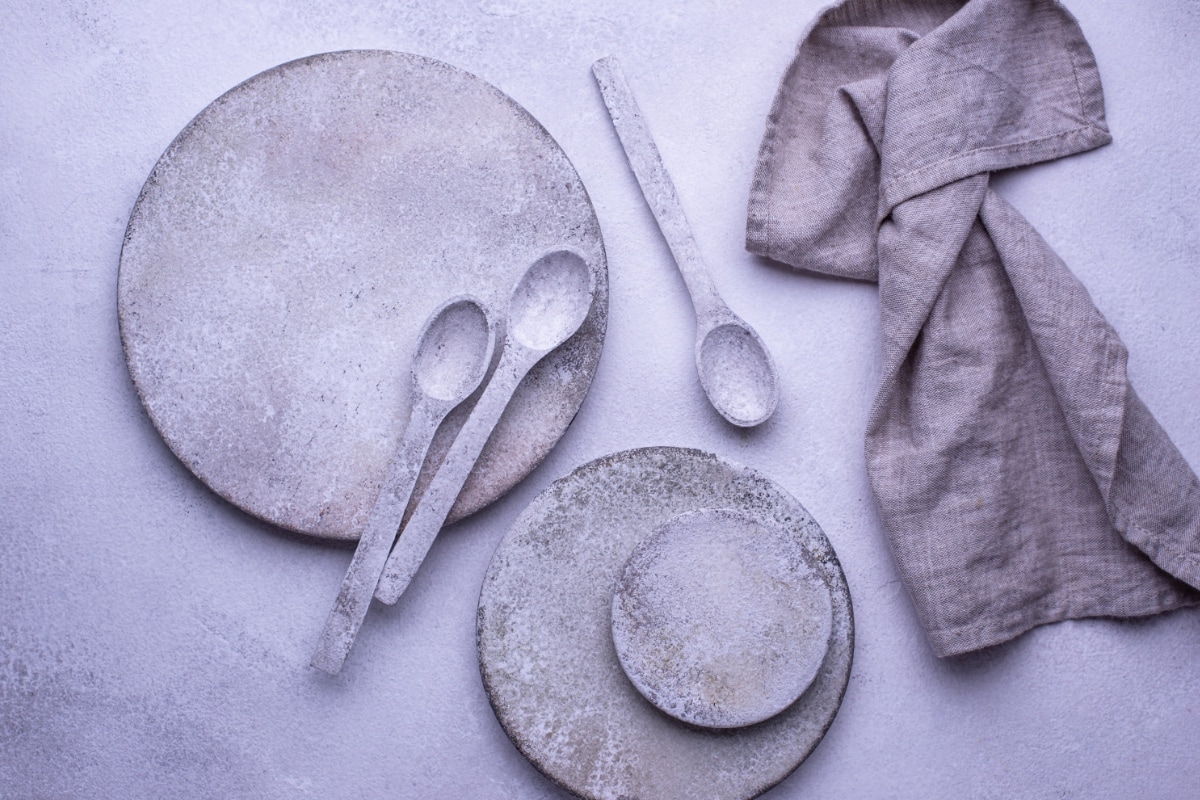
If you want to make decorative items for your garden or practical things like planters, taking up concrete crafts as a hobby might be a good fit for you. Here are a few of the things you’ll need for concrete crafting.
Concrete Mix
Concrete mix is readily available from good DIY stores and is something you’ll need to have in stock for most of your projects.
Silicone Molds
Silicone molds can be used to create objects like planters and statues, allowing artisans to achieve intricate details and replicate their designs with precision.
Concrete Dye Or Pigments
You can add color to your creations by using special concrete dye or pigment, giving your projects a vibrant and personalized touch that complements your design vision.
Concrete Sealer
Once your concrete project is complete, you’ll want to treat it with a concrete sealer to protect your creation from surface damage, staining, and corrosion.
Release Agent
A release agent comes in powder or liquid form and is added to the concrete to prevent it from sticking to the mold.
Embroidery
Embroidery is a lovely craft to get into that allows you to create patterns and images on fabric for use as interior decor pieces and embellish clothes to give them a new lease of life.
Embroidery Floss
Embroidery floss is also called stranded cotton and is a loosely twisted, glossy six-strand thread that also comes in linen, rayon, and silk. You can choose from a huge range of colors to suit your project.
Embroidery Patterns
Embroidery patterns are drawings that you transfer to fabric to embroider. The patterns usually tell you what stitches to use, how many strands of embroidery floss you’ll need, and what colors to use.
What Are The Benefits Of Learning Homeware Craft?
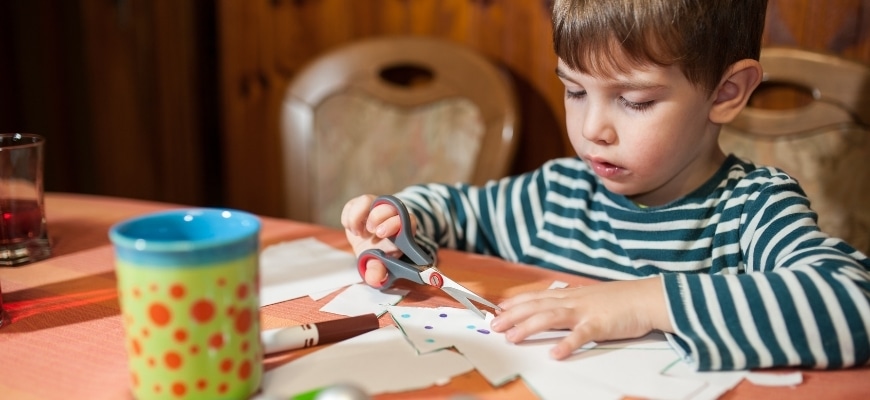
The benefits are undeniable when it comes to learning homeware crafts, and we’ve provided an overview of what’s so great about them.
Creativity And Self-Expression
Everyone has a creative side to their makeup, and designing and creating projects for your home is a great way of expressing yourself and showing what you can do.
Save Money
Buying stuff for your home can be expensive, and making your own things can save you a whole bunch of cash.
Customization
You can use homeware crafts to add a sense of individuality to your home by customizing everything you make, and don’t be afraid to try different techniques to make your pad stand out from the crowd!
Skill Development
Learning to make things really helps to develop new skills, giving you a tremendous sense of achievement, and it’s fun too!
Therapeutic And Stress-Relieving
Spending time concentrating on a project is a great way of relieving the stress of everyday life and is incredibly therapeutic.
Hobby And Leisure
Taking up a new hobby is a wonderful way of filling your leisure time, and houseware crafting not only saves you money and makes your home unique but also gives you the scope to make gifts for friends and family.
Cognitive Benefits
If you’re retired or have a job that doesn’t challenge you mentally, taking up an engrossing craft like jewelry making, sewing, or crocheting is a great way of keeping your brain sharp and active.
Home Improvement
During the recent Covid pandemic lockdown years when we weren’t allowed to go out, many people got into home improvement for want of something to do. That saw a massive uptick in the number of folks getting into houseware crafting.
In the post-pandemic years, that enthusiasm for crafting has endured, so why don’t you jump on the bandwagon if you haven’t already?
How Do You Learn Homeware Crafts?
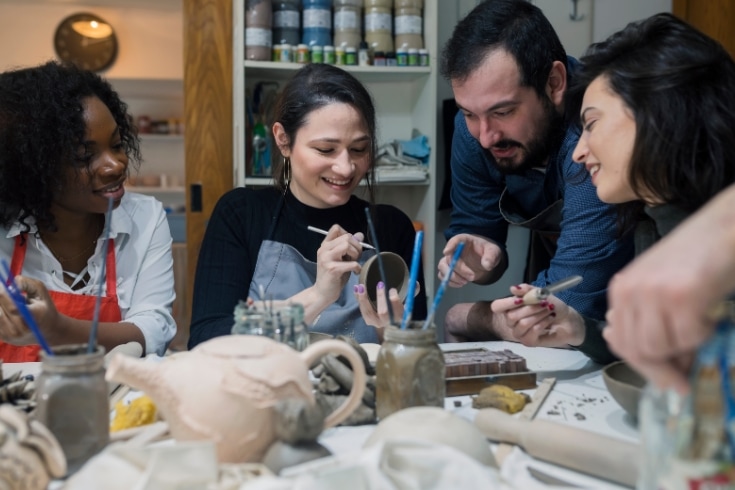
Learning homeware crafts takes time and patience, depending on what craft you decide to take up. Here’s a guide on how you can get into this fabulous field of crafting.
Decide What Craft You Want To Take Up
As you know, there are so many different homeware crafts to take up that it can be difficult to decide what you want to do. Think about how much time you have to dedicate to your chosen craft, what materials and tools you’ll need, and where you can do it. That will help narrow your choices down quite a lot.
Set Up A Dedicated Workspace
Decide where you want to work on your craft and set it up accordingly. Remember, you’ll also need storage space for your tools, materials, and completed projects.
Buy Materials and Tools
Research your chosen craft and invest in the basic tools and materials you’ll need for your first project, ensuring a smoother and more enjoyable creative experience as you get started.
Keep Your Tools And Workspace In Good Condition
No one can work efficiently in chaos, so be sure to keep your workspace clean and tidy and maintain your tools properly.
Learn The Basics
It’s essential to learn the basic skills you need for the craft you want to take up. There are lots of online tutorials on YouTube and websites on every kind of homeware craft, so check those out to get you started.
Join A Crafting Community
I recommend joining a local or online crafting community where you can meet and learn from other crafters.
Practice!
The only way to improve is to keep practicing! If possible, pick up your hobby every day and keep working at it, and you’ll quickly see improvement.
Build A Reference Library
As you progress with your hobby, you’ll accumulate a collection of books and magazines full of useful content that you’ll want to refer to time and again throughout your crafting journey. So, if you have the space, it’s a good idea to set aside a bookshelf or two to create a handy reference library.
Refine And Develop Your Skills
As you get more proficient at your chosen craft and keep practicing, you can start to learn and refine your skills. That will improve the quality of your finished projects and encourage you to take on more challenging ones.
Stay Inspired
To keep progressing in your chosen craft, you need to stay inspired. A great way to do that is by visiting exhibitions and galleries featuring your craft niche and checking out current fashion trends online and in print.
What Are Some Examples Of Products Produced By Using Homeware Crafts?
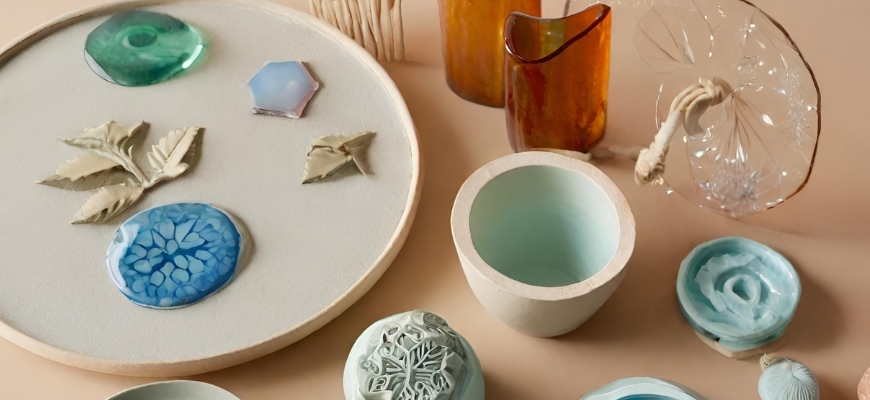
Here are some products you can make using homeware crafts. Of course, this is just a tiny glimpse into the homeware crafting niche and the world’s your oyster when it comes to what products you can make!
Throw Pillows
You can make a throw or toss pillows in a wide range of colors and fabrics to personalize your room’s look. Pillows are simple and quick to make, making this an excellent project for a beginner to the craft of sewing.
Knitted Blankets
If you like knitting, making blankets is a simple project that makes a good starting point. You can choose any color and design you like and make blankets of different sizes.
Scented Candles
Scented candles make great gifts and add a lovely ambiance to a room, especially around Christmas time, when spiced and pine scents are popular.
Ceramic Mugs
Coffee mugs are a simple ceramic pottery project you could try, and they make nice gifts, too; customizing them with personal designs adds a special touch to your present.
Coffee Tables
You can make coffee tables from lumber, metal, glass, or upcycled old furniture, depending on what homeware craft you’re into.
Stained Glass Window Panels
Add a touch of individuality to your home by making stained glass window panels. You can choose opaque finish glass for privacy or go for a more transparent colored style.
Beaded Necklaces
Making beaded necklaces is a popular craft with kids of all ages and can be as complex or simple as you want.
Greeting Cards
Homemade greeting cards, wedding, or party invitations are a whole lot cheaper than shop-bought ones and are always appreciated by the recipient, as the extra effort and thought are clear to see.
Plant Hangers
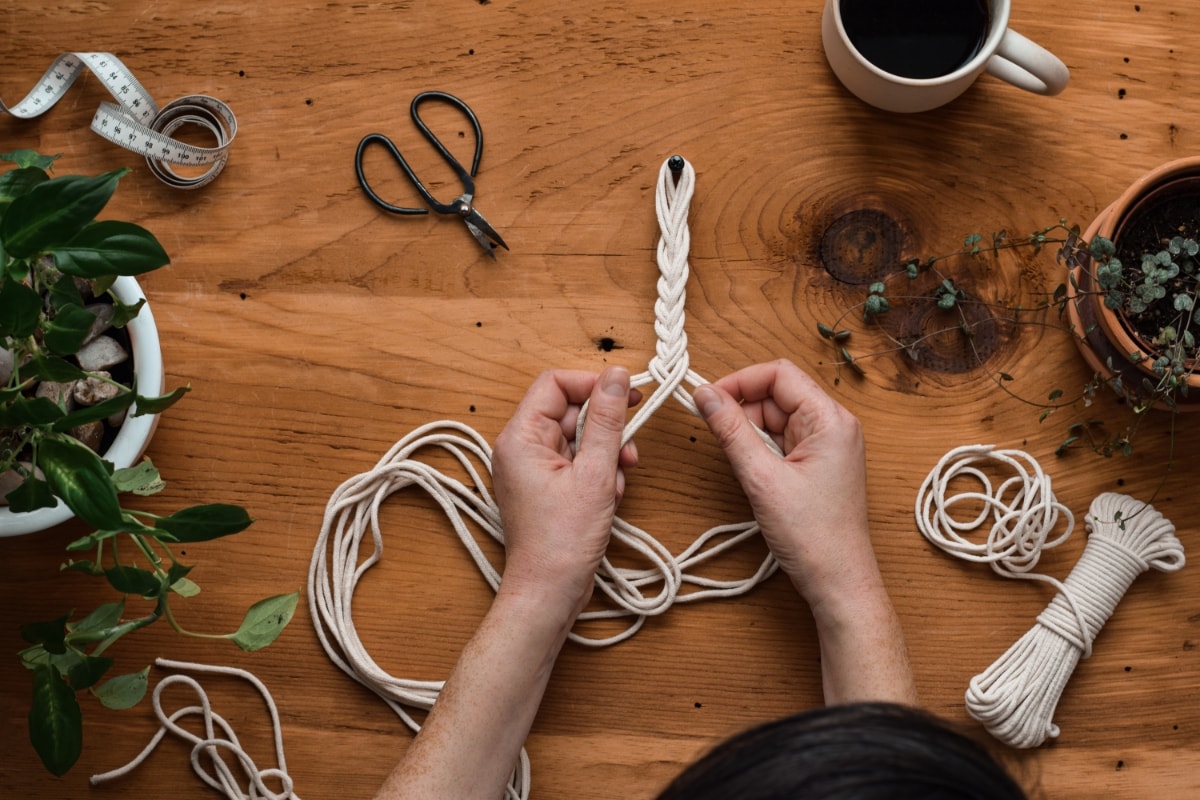
Macramé plant hangers look fabulous in your conservatory or orangery and can be color-coordinated to match your interior decor scheme.
Paintings
Paintings can be large or small and can be displayed in groups of a similar theme to create impact and a focal point in a room. Your own artwork can also make touching family tributes and even heirlooms.
Decorative Wooden Signs
A decorative wooden sign adds character and humor to a garden or patio area. They’re easy to make and make a good starting point for a woodworking crafting hobby.
Suitcase Side Tables
The vintage look is all the rage right now, and reclaimed leather suitcases salvaged from thrift stores and auctions can easily be upcycled for use as quirky side tables.
Concrete Planters
A concrete planter can be any shape or color you want and makes a great statement piece when displayed on a patio, balcony, or doorstep. Handmade planters are much cheaper to make than those you’ll find in your local garden center, and you can make them unique!
FAQs
In this part of our guide, we answer some of the most frequently asked questions about houseware crafting.
How Can I Add A Personal Touch To My Homeware Craft?
Even if you’re following a pattern, you can still add a personal touch to your homeware crafts by choosing the colors and embellishments you use. You could even find a way of adding your initials or a logo to your creations, depending on what craft you decide to take up.
Are There Any Online Marketplaces For Selling Homeware Craft Products?
Yes, you can sell your homeware craft products through online marketplaces such as eBay, Etsy, Facebook Marketplace, Amazon Handmade, and eCrater. There are numerous other potential outlets you could use, depending on your specialist craft, and a quick Google search is the way to go.
What Are The Latest Trends In Homeware Craft?
There are plenty of new and popular trends emerging in homeware crafting right now, including the following:
- Embroidery
- Quilt motifs
- Granny squares
- Punch needling
- Tufting
- Latch hooking
- Sewing clothes
- Crochet
- Knitting
You could boost your income by joining the army of people making crafts to sell, which is another rapidly growing trend in the crafting world.
How Can I Create Homeware Craft Items That Sell Well?
The first thing to do is research the marketplace to find out what’s popular at the moment. Once you’ve nailed down a niche to exploit, you need to become as expert as you can in that craft so that your work is good enough to sell.
Where Can I Find Tutorials For Advanced Homeware Craft Techniques?
The best place to search for tutorials for advanced homeware craft techniques is probably on YouTube. Alternatively, try searching online for your specific craft and enroll with an online college that provides different levels of tuition for their students’ stages of development.
What Is The Typical Time And Cost Investment For Homeware Craft Projects?
The answer to that question is basically, “How long is a piece of string!”
The time you spend working on a project depends entirely on the houseware craft you choose. For example, constructing a large piece of wooden furniture will likely take much longer than making a cushion and will be a whole lot more expensive.
So, essentially, the time and cost investment for homeware craft projects depends on your craft niche.
How Can I Make My Homeware Craft Projects More Sustainable?
There are several easy ways to make your homeware craft projects more sustainable.
- Cut back on waste, e.g., avoid single-use plastics
- Think twice before throwing things away, and recycle where possible
- Use what you already have stashed away in drawers and cupboards rather than buying new stuff for every project
- Shop local and use thrift and charity shops as sources of materials
- Save water by plugging the sink when washing your hands and tools instead of allowing the water to run down the drain
- Use eBooks and patterns instead of paper ones
If you belong to a crafting community, share or swap resources and materials with your fellow crafters to save money and the planet!
Are There Any Homeware Craft Workshops Or Classes Available?
Yes, there are lots of workshops and classes on all kinds of homeware crafts online. Google what you’re interested in, and you’re sure to find something of interest. You can also join local crafting workshops and courses at terrestrial locations.
How Do I Care For And Maintain Handmade Homeware Craft Items?
Again, that all depends on what you make. You can keep ornaments clean by dusting them regularly, wiping glass down with a damp cloth, polishing and waxing wooden furniture, and using washable materials for soft furnishings.
Conclusion
Houseware or homeware crafting takes many forms but essentially involves making something functional or decorative for use around your home.
There are many forms of homeware crafting, including embroidery, woodworking, painting, sewing, crochet, knitting, and pottery, so you’re bound to find something to suit you. Any form of crafting has plenty of benefits to enjoy, such as being a relaxing hobby, giving you a sense of personal achievement, saving money, and even boosting your self-confidence.
Once proficient, you can create and build a huge range of items, such as wooden furniture, jewelry, greeting cards, scented candles, soft furnishings, and clothing. Of course, if you’re an eco-warrior, you could try upcycling old, unwanted items to save money and the planet!
Browse our article and decide what homeware craft niche interests you the most, join a local crafting community, check out some of the fabulous online tutorials available, and get inspired. Oh, and don’t forget to share your early work with us!

